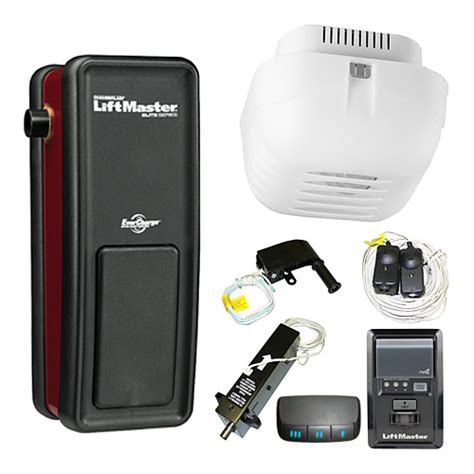Secrets to Fixing Your LiftMaster 8500 Garage Door Opener
The LiftMaster 8500 is a popular choice for homeowners, known for its quiet operation and reliable performance. However, like all mechanical devices, it can eventually encounter problems. This comprehensive guide delves into common LiftMaster 8500 issues and provides practical solutions to get your garage door operating smoothly again. We'll cover troubleshooting steps, preventative maintenance, and when it's time to call a professional.
Understanding Your LiftMaster 8500
Before diving into troubleshooting, it's helpful to familiarize yourself with the key components of your LiftMaster 8500: the motor unit, the control panel, the safety sensors, the chain or belt drive, and the travel limit switches. Understanding how these parts work together is crucial for effective troubleshooting.
Common LiftMaster 8500 Problems and Solutions
Many issues with the LiftMaster 8500 can be resolved with simple DIY fixes. Let's explore some of the most frequent problems:
1. Garage Door Won't Open or Close:
This is the most common issue. Several factors could be at play:
- Power Supply: Check the power outlet and ensure the opener is properly plugged in. A blown fuse or tripped circuit breaker in your home's electrical panel could also be the culprit.
- Safety Sensors: These infrared beams, located near the bottom of the garage door tracks, detect obstructions. If misaligned or obstructed by dust, debris, or even a spiderweb, the door won't operate. Clean the sensors with a soft cloth and ensure they are properly aligned (the light should be unbroken between the sensors). Adjust the alignment screws if necessary.
- Limit Switches: These switches tell the opener where to stop the door's travel. If they're misadjusted, the door might stop prematurely or not close completely. Consult your owner's manual for instructions on adjusting these switches.
- Remote Control Batteries: Replace the batteries in your remote control if the opener doesn't respond.
- Motor Unit Issues: A malfunctioning motor unit requires more advanced troubleshooting and may necessitate professional repair. Listen carefully for unusual noises coming from the motor unit. Grinding or humming sounds often indicate a problem requiring professional attention.
2. Garage Door Opens Slowly or Jerkily:
A slow or jerky operation could indicate several problems:
- Lubrication: Insufficient lubrication of the tracks, hinges, and rollers can cause friction and slow operation. Regular lubrication with a garage door lubricant is key to preventative maintenance.
- Chain/Belt Issues: For chain-driven openers, a worn or loose chain can cause jerky movement. Inspect the chain for wear and tear. For belt-driven models, check for any visible damage to the belt.
- Track Alignment: Misaligned tracks will cause the door to bind and operate poorly. Check for any bends or obstructions in the tracks.
3. Clicking Noise from the Motor Unit:
A clicking sound often means the motor isn't receiving enough power to fully engage. This might be due to:
- Low Battery: This is most relevant if the clicking occurs when using a remote. Change the remote's batteries.
- Overloaded Motor: The motor might be struggling due to ice, snow, or debris buildup on the door, tracks, or rollers. Clean the obstructions before attempting to operate the opener.
- Motor Failure: A clicking sound could also indicate a faulty motor and may require professional repair.
4. Remote Control Malfunction:
If your remote isn't working, try these steps:
- Battery Check: Always start by checking the batteries.
- Signal Interference: Electronic devices can sometimes interfere with the remote's signal. Try moving further away from potential sources of interference.
- Programming Issues: Consult your owner's manual for steps on reprogramming the remote control.
Preventative Maintenance for Your LiftMaster 8500
Regular maintenance is crucial for extending the lifespan of your LiftMaster 8500. Here's a preventative maintenance checklist:
- Lubricate Moving Parts: Lubricate the chain, rollers, tracks, and hinges at least once a year, or more frequently if you live in a harsh climate.
- Inspect Safety Sensors: Clean the sensors and ensure they are properly aligned regularly.
- Check the Tension on the Chain/Belt: Make sure the chain or belt is taut but not overly tight.
- Inspect for Damage: Examine all components for wear and tear, paying close attention to the tracks, rollers, and springs.
When to Call a Professional
While many problems can be addressed with DIY solutions, some issues require the expertise of a qualified garage door technician. Call a professional if:
- The motor is making unusual noises: Grinding, humming, or squealing sounds usually indicate a serious problem.
- The door is operating erratically: Unpredictable movements or failures to respond to commands suggest a malfunction requiring professional attention.
- You are uncomfortable performing repairs yourself: Safety should always be your priority.
By following these tips and understanding the common problems associated with the LiftMaster 8500, you can keep your garage door operating smoothly and efficiently for years to come. Remember, preventative maintenance is key to avoiding costly repairs.

